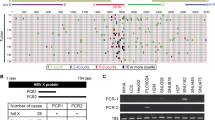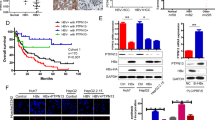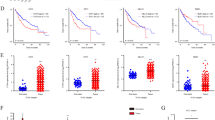Abstract
Aim:
To investigate the mechanism underlying the increase of hepatoma cell proliferation by hepatitis B virus X protein (HBx).
Methods:
HepG2, H7402 and HepG2.2.15 cells, which constitutively replicated hepatitis B virus were used. The effects of HBx on hepatoma cell proliferation were examined using 5-ethynyl-2-deoxyuridine (EdU) incorporation assay and MTT assay. The expression level of MEKK2 was measured using RT-PCR, Western blot and luciferase reporter gene assay. The activity of activator protein 1 (AP-1) was detected using luciferase reporter gene assay. The phosphorylation levels of JNK and c-Jun were measured using Western blot. The expression levels of HBx and MEKK2 in 11 clinical hepatocellular carcinoma (HCC) tissues were measured using real time PCR and Western blot. In addition, the expression of MEKK2 in 95 clinical HCC tissues was examined using immunohistochemistry.
Results:
HBx significantly enhanced HepG2-X cell proliferation. In HepG2-X, H7402-X and HepG2.2.15 cells, the expression level of MEKK2 was remarkably increased. In HepG2.2.15 cells, HBx was found to activate JNK and AP-1, which were the downstream effectors of MEKK2 in HepG2-X and HepG2.2.15 cells. In 11 clinical HCC tissues, both HBx and MEKK2 expression levels were remarkably increased, as compared to those in the corresponding peritumor tissues. In 95 clinical HCC tissues, the rate of detection of MEKK2 was 85.3%.
Conclusion:
HBx promotes hepatoma cell proliferation via upregulating MEKK2, which may be involved in hepatocarcinogenesis.
Similar content being viewed by others
Log in or create a free account to read this content
Gain free access to this article, as well as selected content from this journal and more on nature.com
or
References
Koike K . Hepatitis B virus X gene is implicated in liver carcinogenesis. Cancer Lett 2009; 286: 60–8.
Zhang X, Zhang H, Ye L . Effects of hepatitis B virus X protein on the development of liver cancer. J Lab Clin Med 2006; 147: 58–66.
Liang X, Liu Y, Zhang Q, Gao L, Han L, Ma C, et al. Hepatitis B virus sensitizes hepatocytes to TRAIL-induced apoptosis through Bax. J Immunol 2007; 178: 503–10.
Mukherji A, Janbandhu VC, Kumar V . HBx-dependent cell cycle deregulation involves interaction with cyclin E/A-cdk2 complex and destabilization of p27Kip1. Biochem J 2007; 401: 247–56.
Shan C, Xu F, Zhang S, You J, You X, Qiu L, et al. Hepatitis B virus X protein promotes liver cell proliferation via a positive cascade loop involving arachidonic acid metabolism and p-ERK1/2. Cell Res 2010; 20: 563–75.
Zhang WY, Cai N, Ye LH, Zhang XD . Transformation of human liver L-O2 cells mediated by stable HBx transfection. Acta Pharmacol Sin 2009; 30: 1153–61.
Kim CM, Koike K, Saito I, Miyamura T, Jay G . HBx gene of hepatitis B virus induces liver cancer in transgenic mice. Nature 1991; 351: 317–20.
Kekule AS, Lauer U, Weiss L, Luber B, Hofschneider PH . Hepatitis B virus transactivator HBx uses a tumour promoter signalling pathway. Nature 1993; 361: 742–5.
Natoli G, Avantaggiati ML, Chirillo P, De Marzio E, Collepardo D, Falco M, et al. Modulation of intracellular signal transduction pathways by the hepatitis B virus transactivator pX. J Hepatol 1995; 22: 14–20.
Lee YH, Yun Y . HBx protein of hepatitis B virus activates Jak1-STAT signaling. J Biol Chem 1998; 273: 25510–5.
Diao J, Khine AA, Sarangi F, Hsu E, Iorio C, Tibbles LA, et al. X protein of hepatitis B virus inhibits Fas-mediated apoptosis and is associated with up-regulation of the SAPK/JNK pathway. J Biol Chem 2001; 276: 8328–40.
Wang Q, Zhang WY, Ye LH, Zhang XD . A mutant of HBx (HBxDelta127) promotes hepatoma cell growth via sterol regulatory element binding protein 1c involving 5-lipoxygenase. Acta Pharmacol Sin 2010; 31: 367–74.
Wang Q, Zhang W, Liu Q, Zhang X, Lv N, Ye L, et al. A mutant of hepatitis B virus X protein (HBxDelta127) promotes cell growth through a positive feedback loop involving 5-lipoxygenase and fatty acid synthase. Neoplasia 2010; 12: 103–15.
Pearson G, Robinson F, Beers Gibson T, Xu BE, Karandikar M, Berman K, et al. Mitogen-activated protein (MAP) kinase pathways: regulation and physiological functions. Endocr Rev 2001; 22: 153–83.
Su B, Cheng J, Yang J, Guo Z . MEKK2 is required for T-cell receptor signals in JNK activation and interleukin-2 gene expression. J Biol Chem 2001; 276: 14784–90.
Chayama K, Papst PJ, Garrington TP, Pratt JC, Ishizuka T, Webb S, et al. Role of MEKK2-MEK5 in the regulation of TNF-alpha gene expression and MEKK2-MKK7 in the activation of c-Jun N-terminal kinase in mast cells. Proc Natl Acad Sci U S A 2001; 98: 4599–604.
Schaefer BC, Ware MF, Marrack P, Fanger GR, Kappler JW, Johnson GL, et al. Live cell fluorescence imaging of T cell MEKK2: redistribution and activation in response to antigen stimulation of the T cell receptor. Immunity 1999; 11: 411–21.
Sun W, Wei X, Kesavan K, Garrington TP, Fan R, Mei J, et al. MEK kinase 2 and the adaptor protein Lad regulate extracellular signal-regulated kinase 5 activation by epidermal growth factor via Src. Mol Cell Biol 2003; 23: 2298–308.
Yamashita M, Ying SX, Zhang GM, Li C, Cheng SY, Deng CX, et al. Ubiquitin ligase Smurf1 controls osteoblast activity and bone homeostasis by targeting MEKK2 for degradation. Cell 2005; 121: 101–13.
Hammaker DR, Boyle DL, Chabaud-Riou M, Firestein GS . Regulation of c-Jun N-terminal kinase by MEKK-2 and mitogen-activated protein kinase kinase kinases in rheumatoid arthritis. J Immunol 2004; 172: 1612–8.
Jacqueline B, Fei S, Margherita D, Robert JS . Hepatitis B virus HBx protein induces transcription factor AP-1 by activation of extracellular signal-regulated and c-Jun N-terminal mitogen-activated protein kinases. J Virol 1996; 70: 4978–85.
Witowsky J, Abell A, Johnson NL, Johnson GL, Cuevas BD . MEKK1 is required for inducible urokinase-type plasminogen activator expression. J Biol Chem 2003; 278: 5941–6.
Garrington TP, Ishizuka T, Papst PJ, Chayama K, Webb S, Yujiri T, et al. MEKK2 gene disruption causes loss of cytokine production in response to IgE and c-Kit ligand stimulation of ES cell-derived mast cells. EMBO J 2000; 19: 5387–95.
Cazares LH, Troyer D, Mendrinos S, Lance RA, Nyalwidhe JO, Beydoun HA, et al. Imaging mass spectrometry of a specific fragment of mitogen-activated protein kinase/extracellular signal-regulated kinase kinase kinase 2 discriminates cancer from uninvolved prostate tissue. Clin Cancer Res 2009; 15: 5541–51.
Salic A, Mitchison TJ . A chemical method for fast and sensitive detection of DNA synthesis in vivo. Proc Natl Acad Sci U S A 2008; 105: 2415–20.
Wang FZ, Sha L, Zhang WY, Wu LY, Qiao L, Li N, et al. Involvement of hepatitis B X-interacting protein (HBXIP) in proliferation regulation of cells. Acta Pharmacol Sin 2007; 28: 431–8.
Zhang X, Dong N, Yin L, Cai N, Ma H, You J, et al. Hepatitis B virus X protein upregulates survivin expression in hepatoma tissues. J Med Virol 2005; 77: 374–81.
Zhang H, Shan CL, Li N, Zhang X, Zhang XZ, Xu FQ, et al. Identification of a natural mutant of HBV X protein truncated 27 amino acids at the COOH terminal and its effect on liver cell proliferation. Acta Pharmacol Sin 2008; 29: 473–80.
Winsauer G, Resch U, Hofer-Warbinek R, Schichl YM, de Martin R . XIAP regulates bi-phasic NF-kappaB induction involving physical interaction and ubiquitination of MEKK2. Cell Signal 2008; 20: 2107–12.
Ye L, Dong N, Wang Q, Xu Z, Cai N, Wang H, et al. Progressive changes in hepatoma cells stably transfected with hepatitis B virus X gene. Intervirology 2008; 51: 50–8.
Shaulian E, Karin M . AP-1 as a regulator of cell life and death. Nat Cell Biol 2002; 4: E131–6.
Wang F, Zhou H, Xia X, Sun Q, Wang Y, Cheng B . Activated Notch signaling is required for hepatitis B virus X protein to promote proliferation and survival of human hepatic cells. Cancer Lett 2010; 298: 64–73.
Kim KH, Seong BL . Pro-apoptotic function of HBV X protein is mediated by interaction with c-FLIP and enhancement of death-inducing signal. EMBO J 2003; 22: 2104–16.
Shih WL, Kuo ML, Chuang SE, Cheng AL, Doong SL . Hepatitis B virus X protein inhibits transforming growth factor-beta-induced apoptosis through the activation of phosphatidylinositol 3-kinase pathway. J Biol Chem 2000; 275: 25858–64.
Nijhara R, Jana SS, Goswami SK, Rana A, Majumdar SS, Kumar V, et al. Sustained activation of mitogen-activated protein kinases and activator protein 1 by the hepatitis B virus X protein in mouse hepatocytes in vivo. J Virol 2001; 75: 10348–58.
Acknowledgements
This work was supported by grants from the National Basic Research Program of China (973 Program, No 2007CB914802, 2007CB914804 and 2009CB521702) and the National Natural Science Foundation of China (81071624).
Author information
Authors and Affiliations
Corresponding authors
Rights and permissions
About this article
Cite this article
Kong, Gy., Zhang, Jp., Zhang, S. et al. Hepatitis B virus X protein promotes hepatoma cell proliferation via upregulation of MEKK2. Acta Pharmacol Sin 32, 1173–1180 (2011). https://doi.org/10.1038/aps.2011.52
Received:
Accepted:
Published:
Issue date:
DOI: https://doi.org/10.1038/aps.2011.52
Keywords
This article is cited by
-
The LPI/GPR55 axis enhances human breast cancer cell migration via HBXIP and p-MLC signaling
Acta Pharmacologica Sinica (2018)
-
MiR-19a, miR-122 and miR-223 are differentially regulated by hepatitis B virus X protein and involve in cell proliferation in hepatoma cells
Journal of Translational Medicine (2016)
-
Hepatitis B virus X protein promotes human hepatoma cell growth via upregulation of transcription factor AP2α and sphingosine kinase 1
Acta Pharmacologica Sinica (2015)
-
Hepatitis B virus X protein upregulates Lin28A/Lin28B through Sp-1/c-Myc to enhance the proliferation of hepatoma cells
Oncogene (2014)



